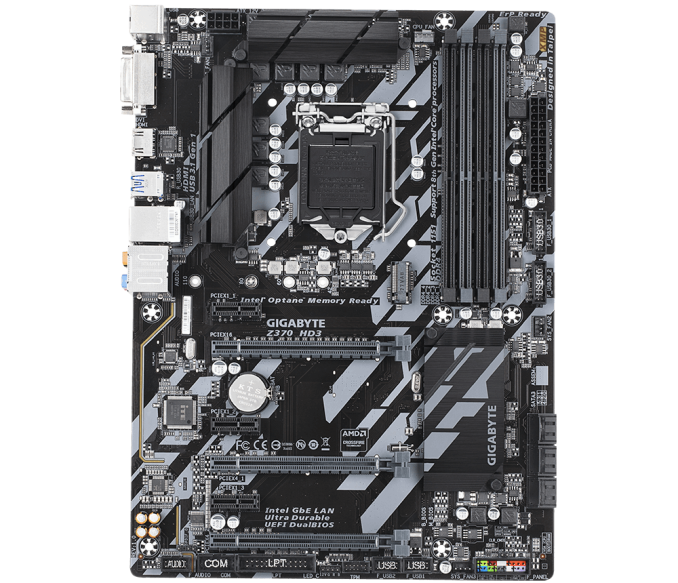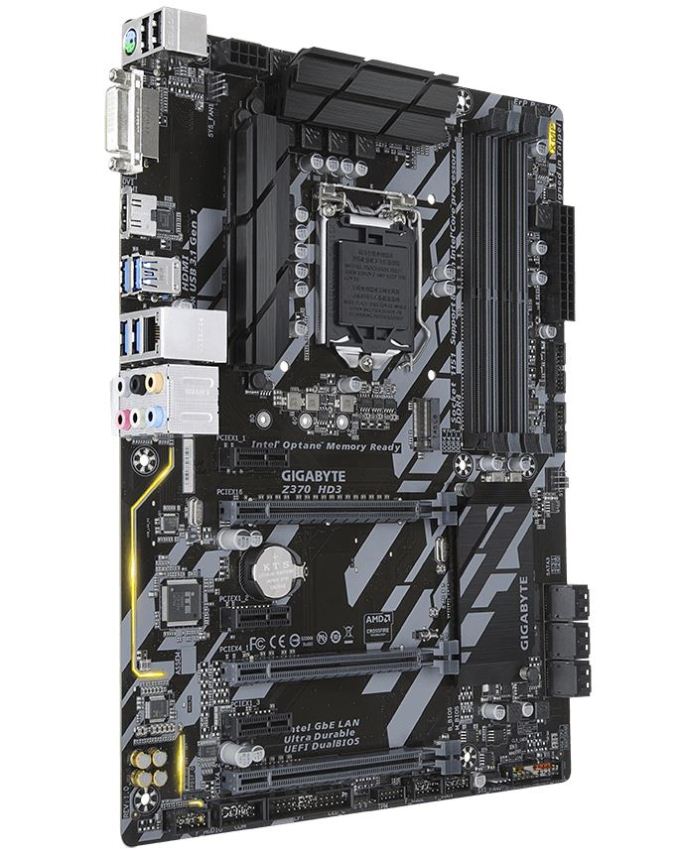Analyzing Z370 for Intel's 8th Generation Coffee Lake: A Quick Look at 50+ Motherboards
by Ian Cutress, Anton Shilov, Joe Shields & Gavin Bonshor on October 20, 2017 2:00 PM ESTGIGABYTE Z370 HD3
The last of the nine GIGABYTE boards for this article is the entry-level Z370 HD3. The HD3 slides in below the HD3P, and despite the minor name difference, has a more different layout than expected. The HD3 is a board for the budget conscious looking to get into the platform at the lowest entry point. For example, the HD3 does not have USB 3.1 (10 Gbps) ports on the board, has only one M.2 slot instead of two or three, and doesn't have slot reinforcement on any PCIe or DIMM slot.
The HD3's appearance is nearly a carbon copy of the HD3P, except the grey stenciling is on the board and chipset heatsink only, and is not on the VRM heatsinks. The memory slots are the same two black and two gray, while all PCIe slots (none with reinforcement) are grey with the PCIe x1 slots in black. The PCH heatsink is also carried over. The only non-standard LEDs on the board is the audio separation line and the XMP notification in the top right-hand corner.
Users still receive the full complement of four memory slots supporting up to 64GB in capacity, while GIGABYTE states a maximum supported speed of up to DDR4-4000. For PCIe, the two full-length slots are wired to run in an x16/x4 configuration driven by the CPU with the third also running at x4 speeds but fed from the chipset. That said, there is only support for 2-Way AMD Crossfire or AMD Quad-GPU Crossfire (2x dual GPU cards) as SLI requires x8 per slot minimum.
As mentioned earlier, the HD3 is down to one M.2 slot, the least on any of the Gigabyte boards. For most users that might be of little concern as they only have one M.2 based drive. The board contains six SATA ports supporting RAID 0, 1, 5, and 10, rounding out storage connectivity. There are a total of four fan headers on the board, with one to the right of the VRM heatsink on top, another close to the EPS 12V connector, while the other two system fans are at the bottom of the board and on the middle right side just above the SATA ports. The included Smart Fan 5 application is still able to control the hybrid PWM/Voltage controlled headers. The audio codec on the HD3 steps down to the ALC892 codec. It also does not have EMI shielding but the board design still separates the boards analog audio components from the digital components on the PCB. For networking, one of Intel's GbE LAN chips covers the network side for the HD3.
The USB side of the house is going to be fairly straightforward. From the chipset, the board has eight USB 3.1 (5 Gbps) ports with four on the back panel and for more available through internal USB headers. Users will also find six more USB 2.0 ports with two on the back panel, and four more available through internal USB headers. There are no USB 3.1 (10 Gbps) ports on this board, allowing for cost savings, although users can still purchase USB 3.1 (10 Gbps) PCIe cards to expand functionality if needed. The back panel IO also includes a combination PS/2 port, a DVI-D video output, a HDMI video output, and the audio jacks.













83 Comments
View All Comments
Aichon - Friday, October 20, 2017 - link
Love this writeup. Thank you guys so much for putting it together so that we can make sense of the choices.peevee - Friday, October 20, 2017 - link
"These motherboards range from $110 "AM4 MBs start from $40 on newegg. Yet another way AMD provides better value.
DigitalFreak - Friday, October 20, 2017 - link
You want a cookie or something?cap87 - Saturday, October 21, 2017 - link
Nobody cares, this a Z370 article. Go back to your cave with the rest of you AMD buddies.imaheadcase - Saturday, October 21, 2017 - link
Apples to oranges.IGTrading - Sunday, October 22, 2017 - link
Very good comment. Not everybody is going to buy a 8700K and thr cheaper CPUs don't really make sense in a 150 USD motherboard.Also, because Intel doesn't guarantee the Boos frequencies anymore, you don't really know what you're going to get with a 8400 for example.
This was very well exemplified here: https://youtu.be/O98qP-FsIWo
psychocipher - Sunday, October 22, 2017 - link
Theres a difference between value and quality. better quality with more features tend to cost more. Dont hate cause amd doesnt get motherboards like the apex. If zen+ increases clock speeds and increases overclocks to where intel is yall will be wishing you didnt buy a cheap $40 b350 motherboard. Yeah you get to keep your cheap b350 motherboard for zen+ but yeah lets buy a new cpu cause amd is providing better value.OFelix - Friday, October 20, 2017 - link
I haven't read the article yet but I want to say that to make sense of 50+ MBs I'm going to need a comparison system which let's me find all MBs with ThunderBolt for example.Brett Howse - Friday, October 20, 2017 - link
Check the last page.Ian Cutress - Friday, October 20, 2017 - link
+1